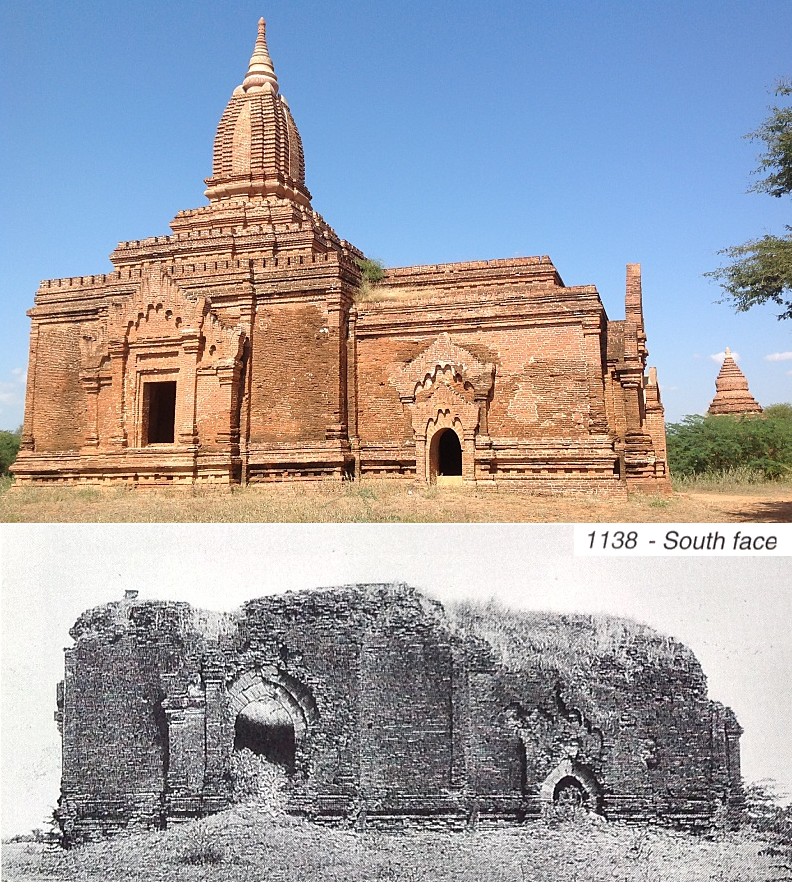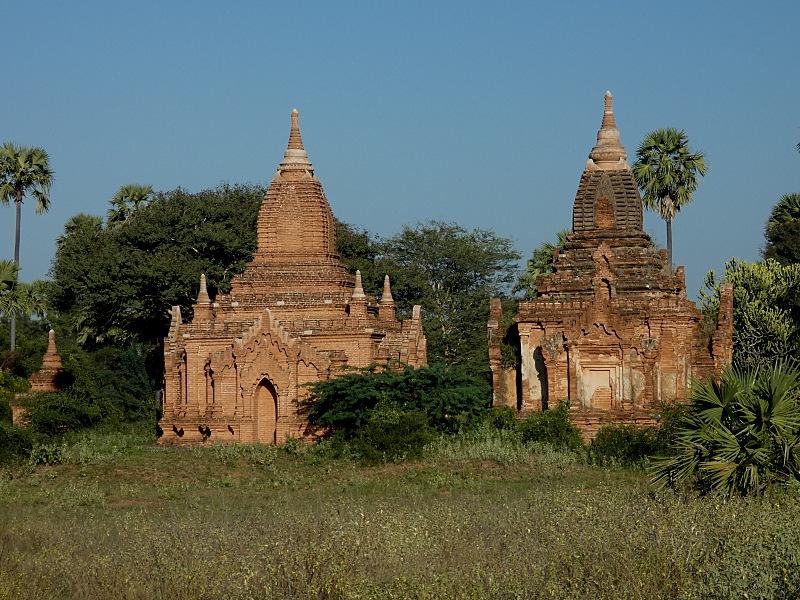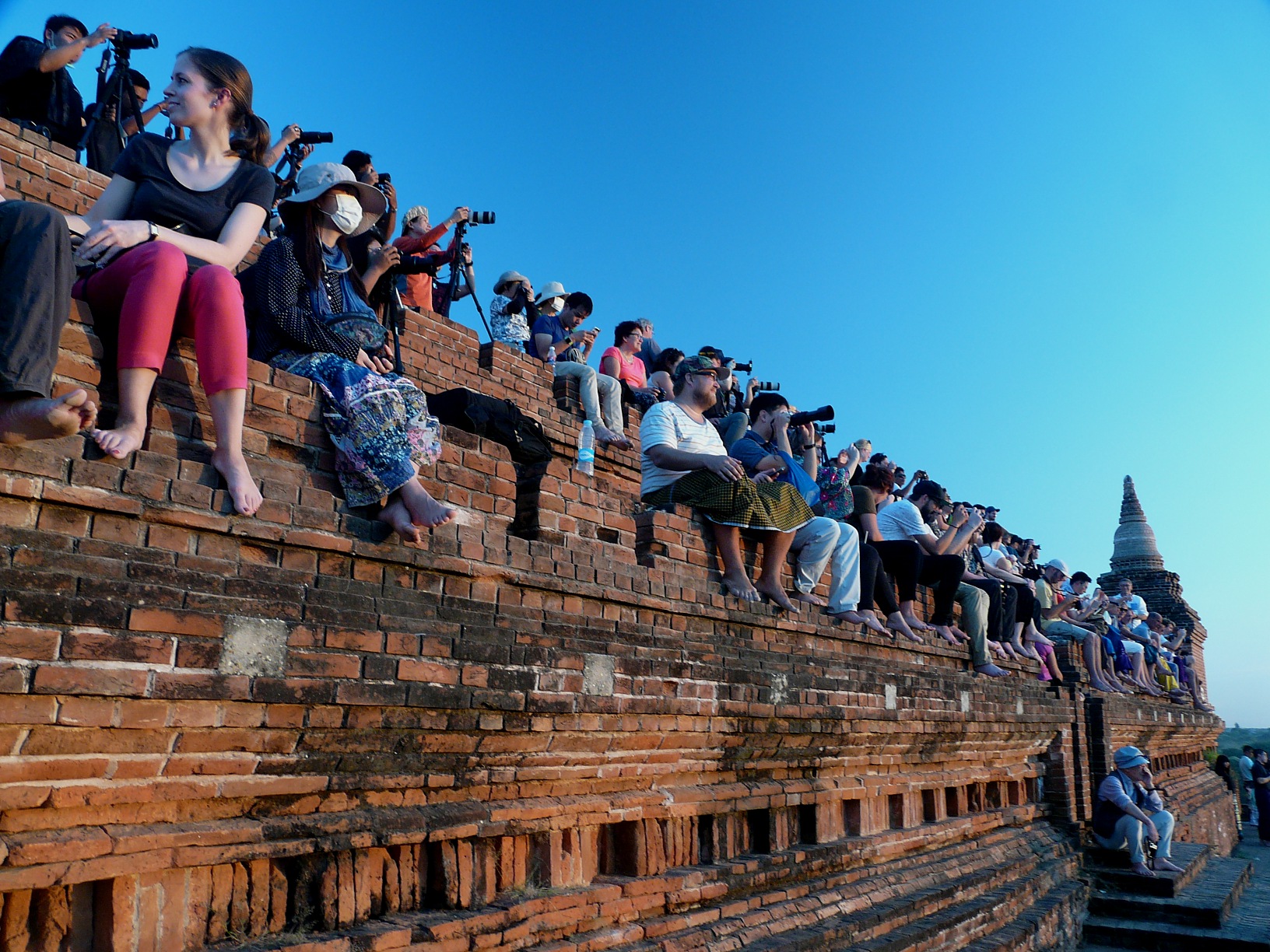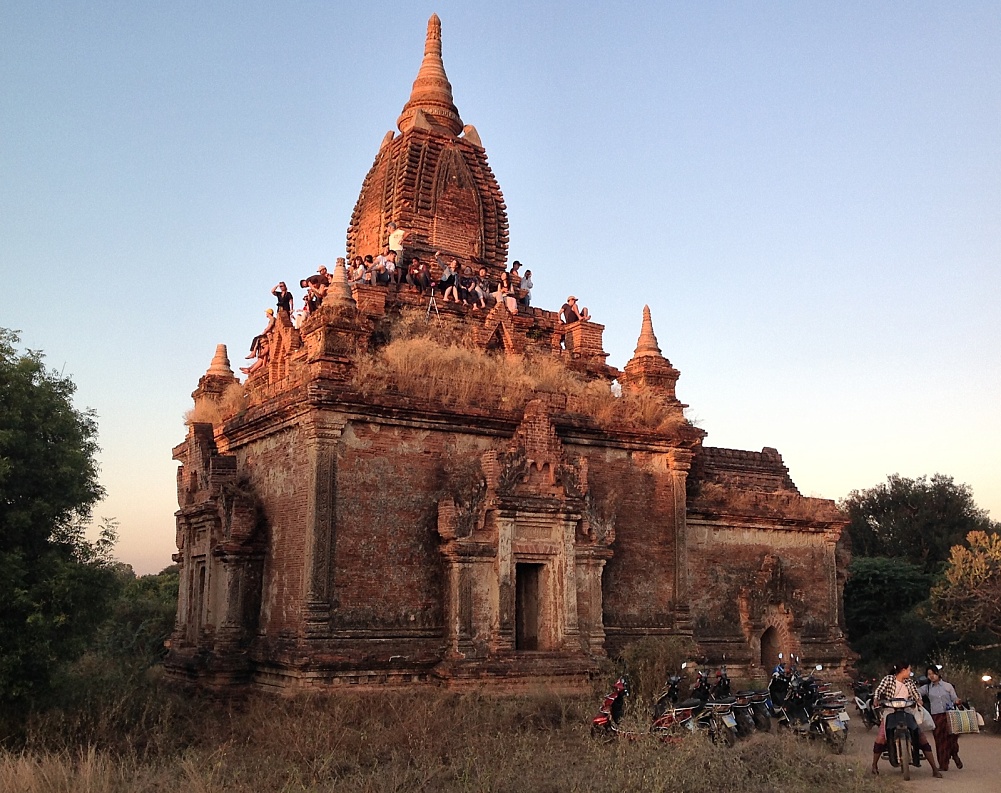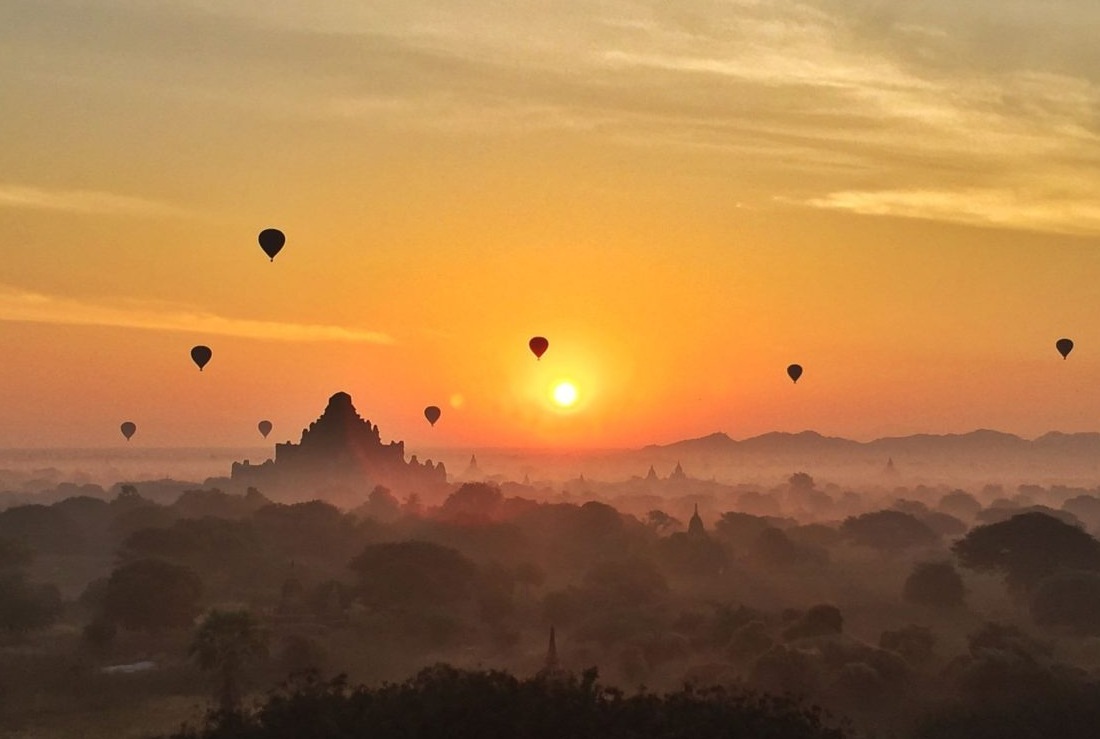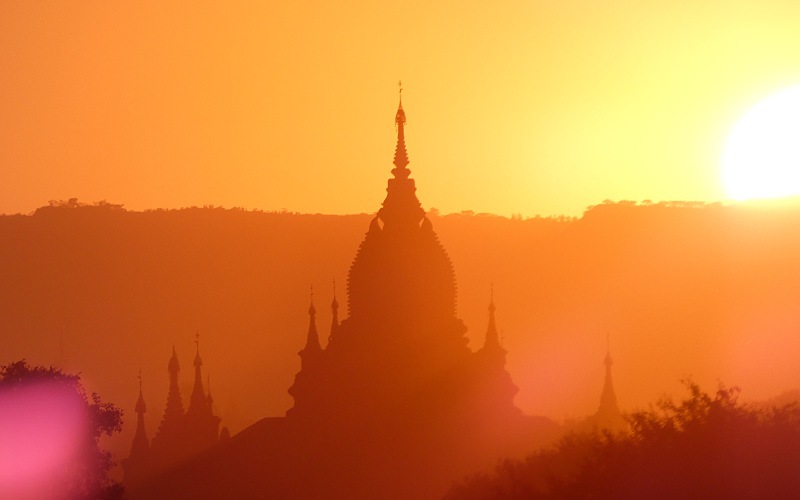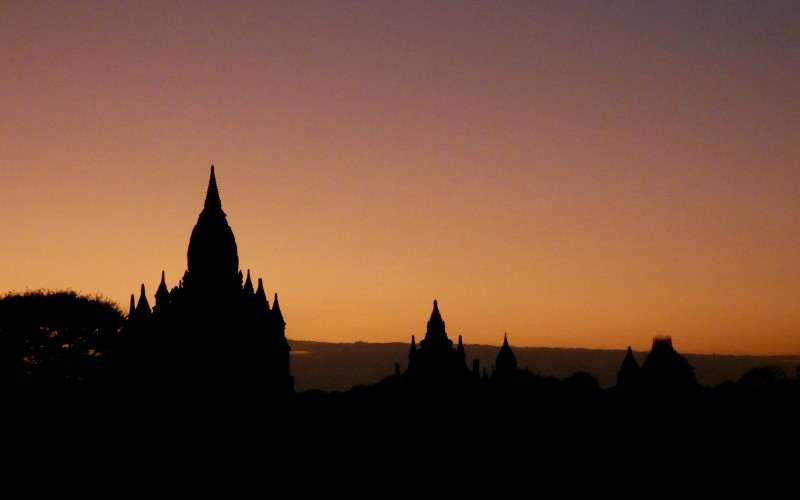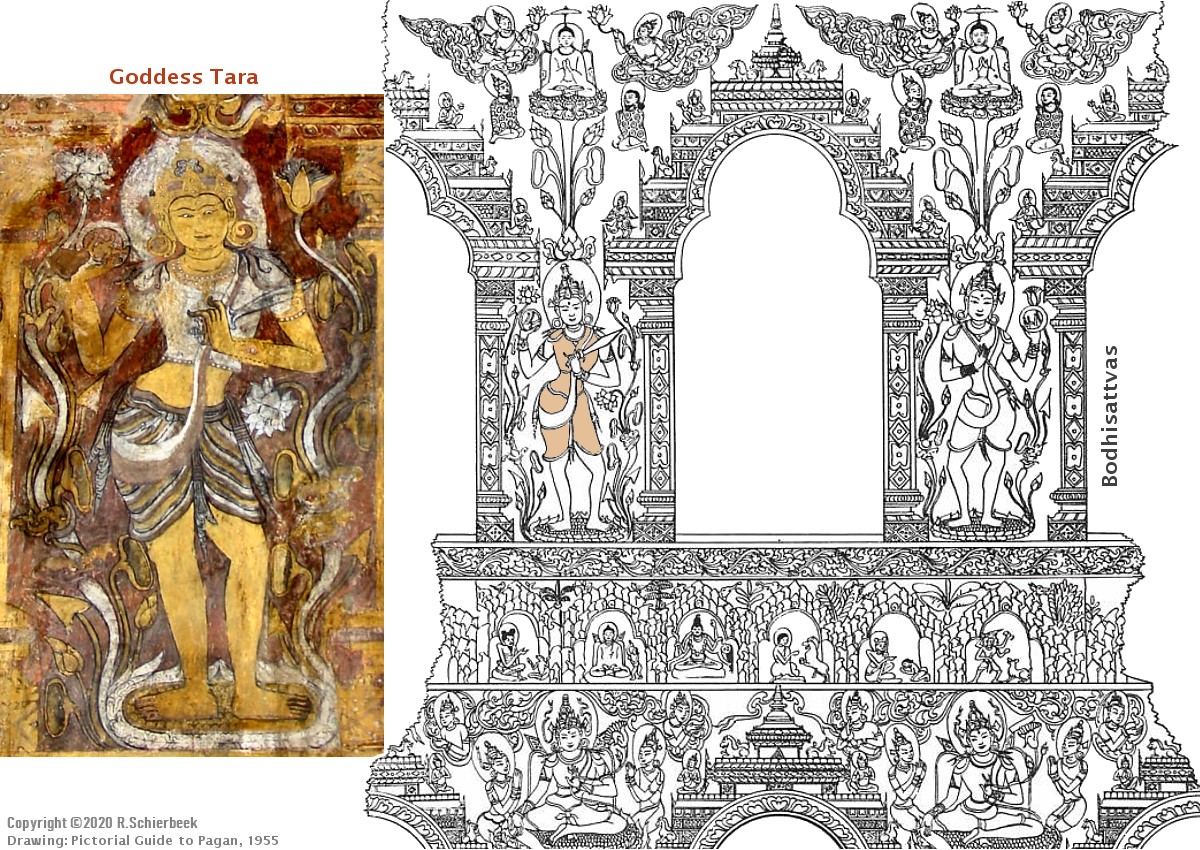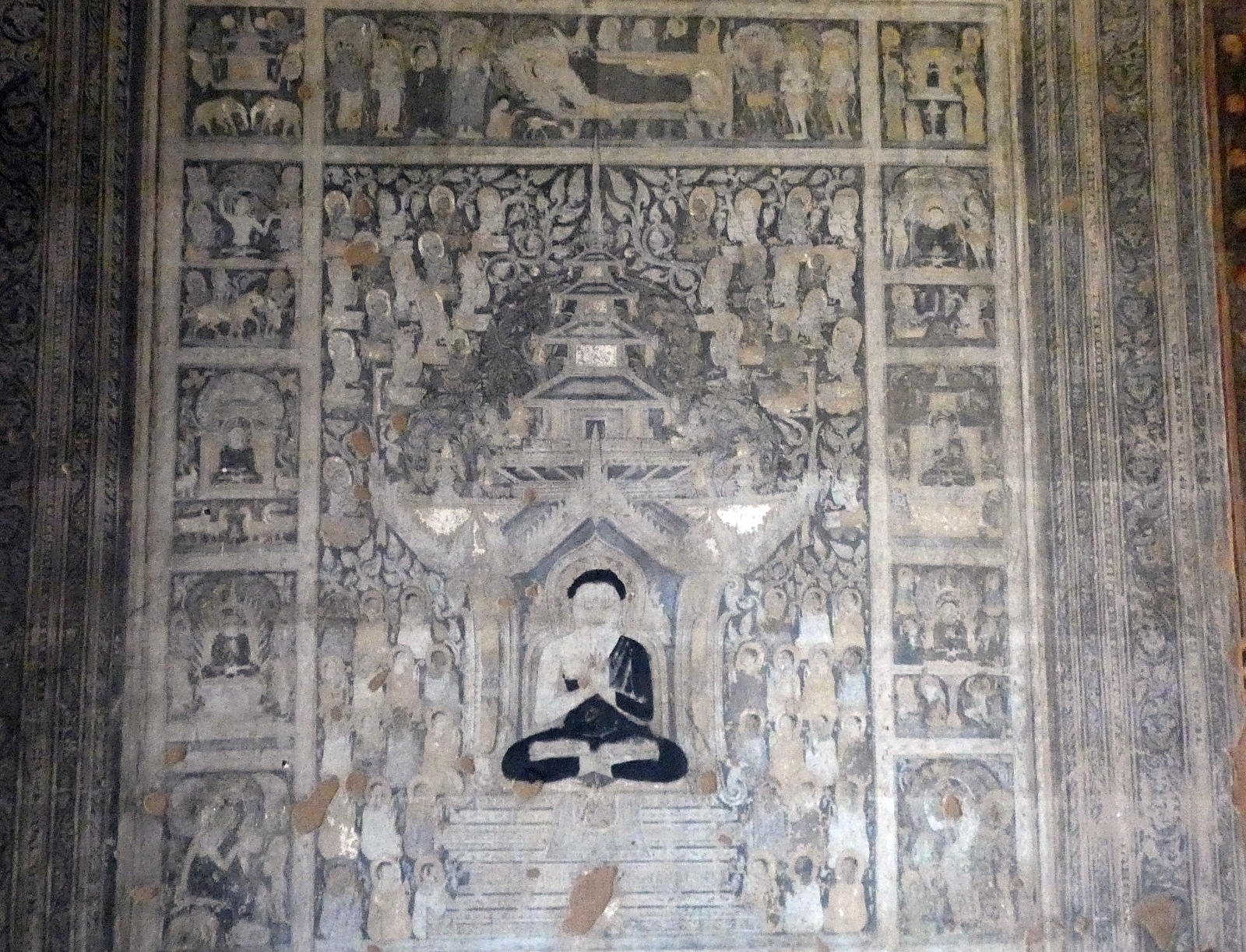|
|
Last update: Apr 21, 2024 The 2730 temples of Bagan.
Introduction.Bagan is a historical city located in central Myanmar, renowned for its vast collection of ancient temples, pagodas, and stupas. The Bagan Archaeological Zone, covering an area of over 40 square kilometers, is home to more than 2000 religeous buildings, many of which date back to the 11th and 12th centuries when Bagan was the capital of the Pagan Empire. Bagan is a UNESCO World Heritage Site, attracting thousands of visitors each year. The temples and pagodas in Bagan vary in size and style, with some towering high above the landscape and others nestled amidst serene gardens. In addition to its architectural wonders, Bagan is also a center for traditional Burmese crafts, such as lacquerware and weaving, and its lively markets give visitors a glimpse into the local way of life. With its rich history and cultural treasures, Bagan is a must-visit destination for anyone traveling to Myanmar. Bagan was the center of a large empire, but the fortified town of Old Bagan had only about 10.000 residents. Some walls and foundations of the citadel of Old Bagan remain, but the northwestern part of the old town has disappeared into the Irrawaddy River. The temples outside of Old Bagan, spread out on the wide central plain, are grand, lofty, spiritual monuments devoted to the Buddha.
Where to stay in Bagan?The overview map below shows the villages of Old Bagan, New Bagan and Nyaung-U (Nyaung-Oo). The charming old town of Nyaung-U is the lively historic "hub" for Bagan; it's where the market, restaurants and shops are. A short distance down south are the airport and bus-station. For the evening out Nyaung-U restaurant street is the place to be.
The major temple zone (red) is where many of the large, royal temples are; around the ancient walled city of Bagan. The ruins of the old walls are still there as well as one entry gate. Booking accomodation in Bagan can be confusing because the 3 locations of Old Bagan, New Bagan and Nyaung-U are very different in character and price. Nyaung-U ranges from budget to mid-range hotels, New Bagan is the mid-range area. On the riverside around Old Bagan are most of the the luxury resorts. A price indication (high-season rates) for the three hotel areas:
Note: the low-season rate of mid-range and top-end hotels can be 20 to 30% less than the high season room rate (December - January).
Where to stay - from cheap to expensive.Nyaung-U is an interesting village, with some colonial architecture and a market which is a hive of activity. Most of the popular restaurants are in Nyaung-U, on restaurant street, though New Bagan also has many restaurants. The busy north-south road from the market towards the airport and the monasteries can make Nyaung-U noisy; in some area's the monks wake up very early in the morning and diligently start their morning chanting. Nyaung-U has many guest houses and cheap hotels, and mid-range hotels towards the western side (restaurant street) and in Wetkyi-Inn. New Bagan has a good range of mid-price accommodations. It was built in 1990, when the government relocated the villagers from Old Bagan, and that is why it lacks the colonial charm of Nyaung U. New Bagan is a pleasant town however; it is very quiet and has some lovely restaurants. The resorts around Old Bagan are the most expensive, here are the luxury hotels on the riverside with a view of the wide Irrawaddy. There are however only a few restaurants here; but a taxi to Nyaung-U takes just 15-20 minutes. Old Bagan is the best location for the popular main temple group, but if you ride on a bicycle or scooter from Nyaung-U towards Old Bagan you will soon notice temples left and right. And even New-Bagan has some fascinating temples very close to it, notably the golden domed Dhamma Yazika. The Airport area has a few new hotels, but no restaurants at all. It seems to be the worst location; only useful if you want to stay very close to the airport or bus station.
Bagan Archaeological Zone tickets.All tourists must purchase a Bagan Archaeological Zone ticket at a fee of 30.000 Kyat; or about 14 US dollars. The validity starts on the day you buy it. In 2018 the Bagan Authorities shortened the Bagan zone ticket validity from five days to three days. They did not reduce the entry fee for the ticket. However, they soon realized that the three-day validity was too short; and sometime in 2018 reverted the validity back to 5 days from the date of the purchase. This is not widely known or published on any official website (there is none for Bagan). Bagan implemented digital ticketing in 2018, incorporating a photograph and a unique barcode, to enable verification. Checkpoints are stationed at various temples, including the renowned Ananda Temple, as well as at sunset viewpoints. It's advisable to photograph your ticket as a precaution against misplacement or loss.
The photo below shows a Bagan official checking the Zone tickets. Which person do you think is the real Bagan ticketing official?
There is room for improvement: the ticket validity starts on the day you buy it. Many travellers will arrive in the afternoon or evening, and cannot take advantage of the first day; they pay for 5 days but have only 4 full days left. Why not start the ticket validity from the next day, if someone arrives in the late afternoon or evening?
E-bikes / E-Scooter and bicycle rental .One can rent an E-bike at many hotels; but for a potential discount, consider checking out one of the numerous e-bike shops. There are many different brands of e-bikes, all from China and without any indication of performance or battery size on the outside. There are roughly two types, a medium size and a large one, which are quite difficult to distinguish, since the markings are all in Chinese. The larger e-bikes usually have a larger battery and better endurance, the smaller bikes will slow down sooner. The standard e-bike can do about 45 km/hour but when going top speed for a full day you may run out of battery power. Test the e-bike before you rent it, and get the phone number of the rental place in case a problem occurs. A top speed below 40 km/hour could signal a weak battery. Be careful when you have limited scooter experience; you will not become a good driver in an hour! That said, there is little traffic in Bagan and no licence checks, so you could try it if you are a good bicycle/moped driver and know your limitations. Drive slowly and stay on the asphalt or hard dirt roads, but be careful, because on soft sand patches are dangerous. Lots of tourists have crashed in Bagan on the soft sand paths, these are very slippery. Perhaps walk a short stretch? Bicycle. If you do not know how to ride a scooter, use a bicycle, horse cart, tuk-tuk or taxi. A foreign country is not a good place to try your first scooter driving, avoid the hospital and use a bicycle! In Nyaung-U town, a good bicycle is difficult to find; making e-bikes the preferred mode of transportation. The distance from Nyaung-U to the Ananda temple near Old Bagan is only about 5km, so on a bicycle it takes about half an hour. The Grand circle route, which goes from Nyaung-U to Old Bagan, south to New Bagan and east to the airport, is about 25km, a considerable journey in the warm, tropical sunshine.
The Royal temples.During the height of the Bagan Empire, which flourished between the 11th and 13th centuries, devout kings embarked on ambitious building projects resulting in massive, grand temples and pagodas. Only the kings of Bagan had the funds and power to create these huge "king-size" temples. The royal temples were acts of merit-making, seeking to collect spiritual blessings and ensure the prosperity of their kingdom. First-time Bagan visitors typically go and visit some of these royal temples; the many smaller temples and stupas are the icing on the cake. The following itinerary covers some of the most significant temples and pagodas in Bagan, in and around Old Bagan. It will give you an idea of the evolution in temple architecture through the centuries. I should mention that there are many exquisite smaller temples, however, out of more than 2000 temples and buildings, it makes sense to start with the grand, impressive and even majectic royal temples. Don't worry; there are just about a dozen of them.
The Royal Temple itinerary.Start at the oldest temple in Bagan, the magnificent Ananda temple (1). Then head west to Thatbyinnyu (2). Thatbyinnyu means Omniscient, and it is the tallest temple in Bagan. Most people enter from the main road, which goes through the remains of the walls around Old Bagan; but the "official" main entrance is from the west. More on the Ananda here: Ananda: the magnificent temple. Next go north to Shwegugyi (3), an unusual temple hidden behind some trees, which was built on a 12 feet high brick platform. More modest than Thatbyinnyu but certainly worth a visit. Notice the original huge wooden doors made of local teak. A bit more north is the Mahabodhi temple, which is not a royal temple, but worth a look. This temple is modeled after the Mahabodhi Temple in Bodhgaya, India, and features a unique blend of Buddhist and Hindu iconography. It has a large pyramidal central tower, which is typical of the Mahabodhi temple; one of the most copied temples in Asia. Then follow the main road west to Gawdawpalin (4), the second tallest temple in Bagan, a refined, elegant temple, the most stylish one in Bagan. Unfortunately, Gawdawpalin was near the epicenter of the 1975 earthquake; and was heavily damaged. The restauration was made with a concrete structure in 1991-92; and the inside is therefore smooth and bare of any murals. Continue south to Mingalazedi pagoda (5), which cannot be climbed but is worth a quick visit. From Mingalazedi one can go east on a hard dirt road which goes past the small Lawkaoushaung temple, and leads to the famous Shwesandaw pagoda (6), which was the popular sunset spot until all temples were closed for climbing in 2018. If you don't like dirt roads then go to the Shwesandaw on the main roads. Just north of the Shwesandaw is the small Lokahteikpan (Loka Hteik Pan) temple, famous for its Buddhist murals or "jatakas". Go back to the main road and turn right, then follow the sign to Dhammayangyi (7). To the east of Dhammayangyi stands the famous Sulamani temple (8) in a large courtyard. The elegant Sulamani is famous for its murals. Sadly, the Sulamani Pahto suffered significant damage during the earthquake of 2016, when the spire tumbled down through the roof of the temple. The final temple in this sequence is Htilominlo, situated midway between Old Bagan and Byaung-U. It is designed in the architectural style of the Sulamani temple. Unlike the Sulamani, Htilominlo lacks the extravagant murals, but its external walls boast intricately carved stucco decorations. This temple, which is not on the map, is actively used as a place of worship. With this, our tour concludes, and you have now visited all the grand royal temples surrounding Old Bagan. Realistically, you will need about two days to see these 7 temples and 2 pagodas. If you stay in a hotel in Old Bagan, and get up early, you might be able to do this tour in one day; but this would probably be rushed and might not be an enjoyable experience.
Temples outside of the Royal Temple itinerary.The Dhamma Yazika, a pentagonal pagoda, is located in the south, close to New Bagan, and not part of Royal Temple itinerary. Dhamma Yazika is worth a visit because it is very different from the usual pagodas and temples. It is located near the village of New Bagan, and one can visit it on the "Grand circle route" around the Bagan plain. The Shwezigon Pagoda is located in the northern part of Nyaung-U town, close to the river. This impressive golden domed pagoda, built in the 11th century, is considered by locals one of the most sacred sites in Bagan.
Ananda: the magnificent temple.The Ananda Pahto, or Phaya, was the first of Bagan's great temples, and remains the most exquisite of all of Bagan's architectural complexes. The Ananda is an elegant, symmetrical structure with the layout of a Greek cross. One of the most noticeable features is the gilded top, the Shikhara, on the center of the building. A Shikhara is a Sanskrit word translating to "mountain peak"; and it refers to the square tower often used in the temple architecture of North India. The Shikhara tower soars to 51 meters. In the realm of Bagan's temples, the Ananda is undoubtedly the supreme pinnacle. Built in 1105 by King Kyanzittha, it emerged, surprisingly, as the foremost among Bagan's grand royal temples. Inside are four impressive gilded standing Buddhas, about 9,5 meters tall, which are facing the four cardinal directions. These statues are all made of teakwood, and represent the Buddhas who have attained enlightenment. The four Buddhas, looking down magnanimously (benevolent, showing kindness or forgiveness) upon the devotee, certainly make a magnificent impression. The statue of Siddhartha Gautama Buddha (563 to 483 BC), is facing west. In the niche to the east is a statue of Konagamana, the 26th Buddha, in the one to the north Kakusanda, the 25th Buddha and the one to the south is Kassapa/Kasyapa, the 27th Buddha.
The Indian government restored the Ananda temple from 2011 to 2018, and removed the whitewash from the walls. When the layers of lime were removed, ancient murals were revealed. The temple is not just popular with western tourists, but also with local Burmese devotees. Once a year, in January, the week-long Ananda Pagoda festival is held. The villagers from around Bagan come to the festival in bullock carts and stay for the duration of the celebration. This is perhaps interesting if you want to photograph local people, but there is a drawback: during the celebration, a thousand monks will continuously chant the scriptures for 72 hours, using big loudspeakers. Unless you understand Burmese and have a deep interest in Buddhism, this may not be a very enchanting experience.
Bagan Archaeological Museum.The Bagan Archaeological Museum in Old Bagan serves as an introduction to the the history and culture of the Bagan Empire. While its architectural design harmonizes with its surroundings, it may appear a bit outdated. However, upon entering the spacious exhibition hall, visitors will discover a remarkable collection, predominantly sourced from local temples. Most exhibits are labeled in English. There is an abundance of inscribed stone tablets and pillars, displaying the significant role of donations within Myanmar's cultural heritage. One section showcases an array of Buddha statues, originally from the Nagayon Temple.
HISTORY.
Temple, pagoda or kyaung?A temple has at least one entrance, but often four gates on all sides of the compass. A temple can be visited to pay homage to the Buddha. A stupa is a small conical structure. Stupas can be seen all over Myanmar. A pagoda has the shape of a large stupa. A Burmese pagoda is a large massive conical shape made from bricks, and usually a solid structure. In Myanmar a pagoda can be named a "Zedi", for example the Mingalar Zedi. Pagodas are built to protect the sacred relics contained within. These relics can be jewels, precious metals, gongs, or Buddha figurines. Pagodas only very rarely have a secret corridor or passage to the relic chamber, usually it is just solid stone. A pagoda can be covered in pure gold; though most are usually covered with cheaper metals like brass. Famous examples of pagoda's are the Shwezigon Paya and Dhammayazika Paya in Bagan, or the Shwedagon pagoda in Yangon which is covered in real gold. The name "Shwe" means gold in Burmese. So, to summarize:
Shin Bo Me Ok Kyaung (right) is very large, about 14m by 14m on its base, and 12 meters high. This building was possibly a library of Buddhist scriptures. The long vertical crack was caused by the 2016 earthquake, which made the northern wall separate from the building. The Shin-Bo-Me OK Kyaung was completely restored in 2020. Many of these small buildings were part of large monastery complexes. For example the Hsin Phyu Shin Monastic Complex on the central plain near near Minnanthu is one of them. This monastery complex of 710 by 800 feet had many buildings, and a large water tank or pond. It is located just west of Minnanthu village, see the map.
The stone inscription at the Hsin Phyu Shin Monastic Complex mentions that King Tasishin Thihathu (meaning: the possessor of a white elephant) built this monastery in 1312 CE. Later this monastery was called Hsin Phyu Shin, which means Monastery of a king who owns a white elephant. It is also referred to as "Monastry of the white elephant".
The monastry buildings or “kyaungs” in Bagan and Mandalay are often stone buildings, and are called OK-kyaung, which means stone monastery. The modern monasteries around Inle lake are typically teak or hardwood buildings, and are just "kyaungs".
The Bagan Dynasty and their temples.The founder of the Bagan Empire and the Bagan Dynasty, around 1050, was king Anawrahta. He constructed the irrigation system which turned the "Dry zone" of central Burma into a rice granary. Anawrahta built both the Shwezigon and Shwesandaw pagodas, the oldest in Bagan. The temples and stupas scattered across the central plain of Bagan appear to have been situated in a somewhat disorganized, haphazard manner. While many temple entrances roughly face east, sometimes allowing the rising sun to illuminate the Buddha statues inside, only a few temples are precisely aligned with the cardinal directions. The illustration below shows the kings of the Bagan Empire; and the many temples and pagodas they built over the centuries. The diagram shows the correct size of the temples, but not the exact orientation.
The Bagan dynasty lasted from the 11th to the 13th century:
There were a few intermediate kings, who did not build any large temples, and are not included in the list above. The first and most famous king of Bagan was Anawrahta, because he created the empire. The last king, Narathihapati, was much less famous; what follows is a short anecdote about the king with the complicated name. King Narathihapati.Narathihapati was known as the king who fled from the Mongolian invasion in 1277 – 1978; namely Kublai Khan's Mongol army. Paul Strachan, in "Imperial Pagan", describes Narathihapati as a decadent king, and writes that Tayok Pye means "Fleeing from the Chinese". Historians are not sure if the Mongol armies ever reached Bagan (they got quite close according to Marco Polo), but they agree that with Narathihapati's hasty departure, the Bagan empire ended. King Narathihapati is remembered in Burmese history as Tayok-Pye Min, or "the King who fled from the Chinese". In 2019 the Tayok Pye temple was renamed to Narathihapatae Hpaya, after the king who built it. Perhaps the ignoble name "Tayok Pye" made the authorities change it to Narathihapatae? King Narathu's Dhammayangyi.Narathu, the most infamous king of Bagan, ascended to power by assassinating his father, Alaungsithu. For good measure he killed his elder brother as well. Later in life he also killed his wife, an Indian Princess, with his own hands in a wave of anger. Perhaps to atone for his sins, he started to build the Dhammayangyi, a massive, pyramidal, imposing temple, which Narathu never finished. Despite its unfinished state, the colossal Dhammayangyi Pahto dominates Bagan's central plain, evoking a sense of omnipresence. It is easily recognisable in many sunset photos, because the tower or Sikhara is missing, probably damaged by an earthquake. The story does not end here. The murdered Indian Princess was a daughter of Pateikkaya, a tributary kingdom in West-Bengal, near present-day Chin State. In 1171, the chief of Pateikkaya, after hearing about the fate of his beloved daughter, sent a group of eight assassins to Bagan. These assassins, disguised as Brahmin astrologers, managed to gain an audience with King Narathu while hiding their swords underneath their robes. Swiftly and fatally, they stabbed the king. As palace guards hurried to the scene, the assassins took their own lives. The reign of Narathu reached its end, and his karmic consequences caught up with him. And that is why Dhammayangyi is haunted, and was never finished.
Burmese Temple and Stupa evolution.The most common Bagan temple design originates from the Hindu temples of Northern India. The illustration shows the architecture of one of the smaller types of the Bagan temples. It is a one-story temple and quite common on the Bagan plain; there are dozens of this type. A few examples of this temple type are the Gubyauk-Gyi (Myinkaba), Narathihapatae Hpaya, North Guni, South Guni, Shwe Leik Too, Seinnyet Ama and Thabeik Hmauk. Thitsarwadi has a similar construction, but is a three-story temple.
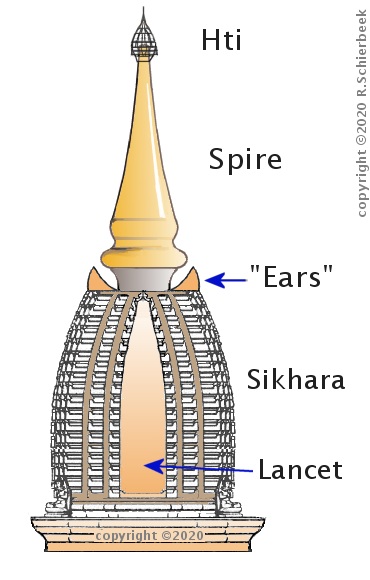
The naming convention is from the book "Inventory of Monuments at Pagan", by Pierre Pichard. The inventory covers more than 2000 monuments within an area measuring 13 by 6 km; each monument was measured, photographed, and described. This Herculean field-work began in 1982 and took nearly a decade, ending only in 1991. In 13th-century Bagan, Sikhara were constructed in large numbers. Sikhara or Shikhara is a Sanskrit word translating literally to "mountain peak"; and it refers to the square tower often used in the temple architecture of North India. The Sikhara is the holy part of the temple and symbolizes the peak of a mountain. The architectural point of the Sikhara is the transition from the square shape of the main temple building, to the round spire. The "cats' ears" are placed on the corners of the square Sikhara; and these often become clearly visible on sunset photos. The Sikhara below has a decoration on the tower lancet; a female goddess. The decorations on Sikharas vary, but the female goddess in lotus position is the most common.
The Flaming arch pediment is a defining element of most of the Bagan temples, unique to Burmese temple design. The flaming arches decorate many temple entrances, but also windows everywhere. The arches are made of stucco or plaster, which was applied wet, moulded, and allowed to dry.
Stupa evolution.In most countries Buddha statues outnumber stupas, in Myanmar however, stupas vastly outnumber Buddhas. The earliest stupas in Myanmar were constructed by the Pyu people, and the distinctive bulbous Pyu-style marked the beginning of the Burmese stupa tradition. One notable example of this Pyu-style stupa is the Bupaya stupa, located on the riverside and considered the oldest in Bagan. The cylindrical Lawkananda pagoda (also known as Loka Nanda paya) represents the next development in stupa architecture. Situated south of Thiripyisaya along the river bank, near New Bagan, it houses a sacred Buddha tooth relic gifted by the King of Sri Lanka. King Anawrahta built Lawkananda along with its larger counterpart, the Shwesandaw pagoda. The Shwedagon pagoda in Yangon stands out with its more contemporary design, which evolved from a stupa that predates the existence of Yangon city itself.
In addition to the numerous "Burmese stupas" found in Bagan, there are also several "Sinhalese stupas" with distinct characteristics. Sinhalese Buddhist stupas can be easily identified as they evolved from the Indian style of stupas, starting with the Sanchi stupa. A defining feature of the Sinhalese stupa is the presence of the "Harmika," a square chamber located on top of the dome. The Sanchi stupa holds great significance in Indian architecture and was constructed by Emperor Ashoka in the 3rd century BCE. It stands as the oldest stupa in India and serves as the prototype for many stupas with large hemispherical domes, particularly in Sri Lanka. Sri Lanka, being an island in close proximity to India, embraced Buddhism early on, which explains its strong Buddhist culture today. In contrast, India has reverted to Hinduism and Islam, and Buddhism has largely vanished. Burma, with its close connections to Sri Lanka, experienced the influence of Sri Lankan Buddhism and architecture. Typical Sinhalese stupas consist of a square terrace supporting a large hemispherical dome. Atop the hemisphere sits a square enclosure known as the Harmika. Above the Harmika is a tapering umbrella-like structure, originally consisting of three disks, which later evolved into a conical spire with multiple rings or disks. This umbrella symbol is called a Chatra, it has a central pillar (Yashti); which symbolizes the cosmic axis. The three disks or umbrellas represent the Three Jewels of Buddhism.
The architectural parts of the Sinhalese Buddhist stupa from bottom to top are:
The triple parasol on the top, the "Chatra", branched out into different incarnations in the countries that border India. Other Buddhist countries went in different directions with their stupas; with different shapes and esoteric symbols. Sri Lanka copied the Sanchi stupa closely, but they used a much larger spire with concentric disks on top. The triple umbrella went from three umbrellas to a spire with many concentric disks. Bagan's kings used this same large conical spire on some pagodas and temples, and this makes the "Sinhalese stupas" in Bagan easily recognisable. In Tibet, a similar spire, made from a pillar (Yashti) and the concentric disks, became a symbolic representation of a Bodhi tree or "Tree of life". The best example of a typical large hemispherical Sinhalese stupa in Bagan is the Sitanagyi / Seddana Gyi pagoda; another much smaller pagoda is the Seinnyet Nyima pagoda. Other temples with the "Tree of Life spire" on top are the West Petleik temple, Pebingyaung Pagoda (1653), and the Abeyadana temple. Now you might think some of these very large stupas are pagodas. Well, for historians and archaeologists all pagodas are large stupas. A very large stupa can be called a pagoda, but for experts it is part of the objects in the "stupa" group. The origin of the word pagoda is possibly from Sri Lanka, it may be a variation of the Sinhalese "dagoba".
In search of hidden Bagan.Sitanagyi: the Sinhalese pagoda.(Also: Sitana Gyi, Sittana, Saytanagyi, Saytana Gyi, Seddana)
Just a bit south of New Bagan, Sitanagyi (Sitana Gyi) pagoda sits a bit forlorn on the Bagan plain, and being a bit off the usual routes; it is not popular with the local Burmese, nor with western tourists. It is mentioned in some guidebooks, but these guides also mention that the pagoda is rarely visited. It was off the tourist route until 2019, perhaps overlooked by most people who just do the regular route around Old Bagan. But since 2019, a few people seem to have discovered this very large pagoda. Sitanagyi is a Sinhalese type pagoda; built by King Htilominlo, also known as King Nadaungmya, in the 13th century. It has a larger footprint than Mingalar Zedi, and certainly a larger volume, as it has an enormous bulbous dome, typical of Sinhalese pagodas. It is surrounded by a square courtyard, and plenty of trees.
The first time I saw the massive Sitanagyi pagoda was in 2016, a few months after the earthquake had struck. It had taken the top off the enormous pagoda, a huge conical spire which had tumbled down and destroyed quite a lot of brickwork on the way down. This spire had only just been reconstructed in 1997. Unfortunately, 19 years after the reconstruction, the 2016 earthquake shook the new spire off, as it did with many spires in Bagan. I was very surprised at the sight of such a large pagoda, outside of the tourist area. The very friendly caretaker seemed a bit saddened by the damage to his pagoda. He made a sad impression on me, but I could not verify that, because he didn't speak much english at all. After I had walked around and taken some photos, he pointed at a tiny door, perhaps the size of a window, on a corner of the pagoda, and suggested a visit inside. Normally, a pagoda is a large solid structure, which cannot be entered. In the heart of an important stupa or pagoda is usually a relic chamber, with a hair of the Buddha in it, or something similarly important.
Only a very few of the large pagodas have an entrance, which is often bricked up, and then there is usually a complex labyrinth of tunnels to confuse any treasure hunter. According to Paul Strachan, (*PS, 1990, p43), the Sitanagyi has such a labyrinth, which should lead to a relic chamber:
So, if you choose to enter the labyrinth, you are in for an Indiana Jones type of adventure. Probably with less scary cinematic effects, and more ordinary obstructions, like a massive wall blocking the passage.
I had one look at the little entrance door, which seemed like something out of Alice in Wonderland, and refused politely. I should mention here that I am a quite tall Dutchman who sometimes has a bit of difficulty getting up and down the little stairways of the temples, which are built for Burmese people, not tall foreigners. In fact, Myanmar's average height of the male population is 163,5 cm (5ft 4.5inch), which is on the small side. And 7 centuries ago, the average human was even smaller. I have enjoyed going up and down the little stairways of many small and large temples, when all temples in Bagan were still open for doing such things, usually at sunset. Those were the days! Since 2018 all these little stairways have been closed off, and entry to upper floors is now prohibited. However, the next year I found myself in Bagan again, and had a second chance at going into the little door, which was perhaps 50cm wide by 1 meter high.
I had to squeeze in backwards to get into the temple, and stepped onto a sandy floor below me. I found myself standing in a long dark corridor, which was wider than the doorway, and after switching on my flashlight, started walking to the back. I was in for a surprise. To be continued ...
Temple restoration from 1980 onwards.
There are inscriptional records of damage to buildings by flooding in 1331, by treasure hunters in the fifteenth, sixteenth and eighteenth centuries, by looting during the Ava-Hanthawaddy wars of 1742–1754, and by at least sixteen earthquakes between 1174 and 1975 (Hudson, 2008). Gordon Luce was one of the first researchers of Bagan; in his book "Old Burma - Early Pagan" (1969) he writes:
The most disastrous damage however, came when the 1975 earthquake hit Bagan. Many of the thin spires fell off, and Sikhara towers collapsed. Walls and domes of buildings cracked, and stucco decoration fell off. The photos of the "Inventory of Monuments at Pagan" by Pierre Pichard show that not a single spire is left on the temples. Immediately after the earthquake, the Myanmar Authorities approached UNESCO for technical assistance, and three subsequent projects were implemented from 1980 to 1994 under UNDP funding. Pierre Pichard began field work to make a comprehensive inventory of monuments, and compile an archaeological map of Pagan; this project was sponsored by UNESCO and the École française d'Extrême-Orient (EFEO).
Most of the large temples were relatively undamaged, but of the 790 small temples 448 have been completely rebuilt since the 1975 earthquake (Hudson, 2008).
Temple nr. 1138 below, located just east of New Bagan, has been restored from a ruin. The black and white photo is from the Inventory by Pichard (1992). The newly built first floor and Sikhara are completely conjectural, and not based on any historical evidence. This temple is now empty inside, and unused, just like many other "restored" or newly built temples around Bagan.
In 2005, a UNESCO official told the International Herald Tribune that “a Disney-style fantasy version of one of the world’s great religious and historical sites is being created by (the military) government. They use the wrong materials to build wrongly shaped structures on top of magnificent ancient stupas”. (mmtimes.com )
The Burmese vision of Bagan.The local Burmese have a very different view of the temples than the average tourist; for them Bagan is a living monument. For example, during the Ananda Pagoda festival, thousands of people from local villages make a pilgrimage to Bagan in oxcarts. Monks recite Buddhist sutras with loudspeakers and amplifiers set at maximum volume; the Ananda Pagoda is filled with crowds of visitors. A Burmese devotee worshippes the Buddha statue as an idol; for tourists it is a piece of history to be conserved. For the worshipper, lighting a candle or incense stick right next to a Buddha statue is a sign of devotion, for the historic value the soot marks are detrimental. So, the Burmese people often have an opposite point of view as the western tourists. They focus on Buddhism; where tourists focus on history and authenticity. Western tourists come for authentic old temples with at least a 700-year long history, Burmese come to pay homage to the Buddha in a shrine. Authentic Buddha statue or not, it makes little difference.
Examples of restoration and modernization of Bagan.The very large temples were quite sturdy, solid constructions, and were less damaged than the small ones. But the large temples have not escaped "modernization": for example, the Shwesandaw pagoda was in its original condition until 1957: no plaster covered the red bricks. But in that year the pagoda trustees led by the monk Sayadaw U Wayama renovated and embellished it with plaster and lime washing. So, it now looks like a more modern structure, but - the white paint becomes dirty quite soon, and the pagoda needs a new layer of paint every year. (http://www.baganmyanmar.com) In 1975 the large Gawdawpalin temple was seriously damaged by the earthquake, and it was extensively restored and rebuilt with a solid concrete core in 1991-92. There used to be glazed tiles of plaques adorning the structure; but due to theft and vandalism in past times, only a few tiles are left. (www.baganmyanmar.com, orientalarchitecture.com) The murals of the Ananda Pagoda, the most impressive in Bagan, were whitewashed from 1975 onward by the government. In 2015, during a six-year project, many layers of lime were stripped off, and revealed ancient murals. Historian and archaeologist Tampawaddy U Win Maung said (Myanmar Times, 16 Jan 2015): “There are many priceless murals in Bagan’s temples, but most are covered with lime because some incompetent conservators had no idea what the murals meant. All they know is to paint the temples sheer white, which destroys the authenticity. Donors were too dedicated to renovating the pagodas and they wanted to make the entire pagoda look like new, regardless of whether there were mural paintings.” (mmtimes.com )
The "new" copy-paste temples have an omission; which is the stucco on the walls. Hundreds of years ago, the temples would have had stucco on the outside walls, but a freshly plastered wall on a new temple would probably be too ostentatious. A new, bright white temple would stick out like the proverbial sore thumb, so that is not done. If you get close to one of these new buildings, it is pretty obvious that it is a modern construction. Is Bagan a Disney-style fantasy? Are there any ancient, original, unspoiled temples left? You might imagine some small overgrown little crumbling temple, but, believe it or not, there are many impressive and fascinating temples beyond the usual tourist routes. There are many amazing, old, authentic, and original temples off the well-trodden path. There are many well-hidden objects like temples, kyaungs and meditation caves. If you have more than a few days in Bagan, go and explore out of the grid. Find the real Bagan.
Restoration after the 2016 earthquake.The Thatbyinnyu temple is a rather stumpy, solid structure, and though it is the tallest in Bagan with a pinnacle height at 66 metres, it is not the most elegant. A temple like the Thatbyinnyu needs a strong structure, because a fragile building like a French gothic cathedral would not last long in Bagan.
In 2020 there were more than 200 small earthquakes recorded in Myanmar. Myanmar is located on a large earthquake fault, the Sagaing fault, and Bagan, which is located close to a subfault, has survived many earthquakes, for example in 1975 and in 2016. On the 24th of august 2016 Myanmar was hit by a 6.8-magnitude earthquake. The epicenter was in Chauk in central Myanmar. Chauk is just 30km south of Bagan on the way to Saleh, which is also a tourism destination. In Bagan more than 400 temples were damaged. The Sulamani, North Guni and Mingalazedi temples were seriously damaged; as were the lesser known Gubyaukgyi (Nr.298), Sitanagyi and Tayoke Pyay. Most of the damage done by earthquakes is to the Sikhara and the spire; that is why almost all the spires in Bagan look like they were made recently. The Sikhara of Htilominlo was rebuilt during 2019-2020, and reinforced with a steel frame.
There are an estimated 2200 temples in Bagan; but many of these are small stupas, little brick temples or even ruins. There are perhaps only about a dozen "grand temples" like the Ananda Pahto, Dhamma Yazika and Sulamani temple that are on the must-see list of most visitors. Of the 2200 temples 453 have had earthquake damage; it is usually the top or spire that has been displaced or fallen off. The quake reduced 17 small temples and stupas to rubble, however most temples had just minor structural damage. UNESCO Myanmar has been coordinating an international team to work on the monuments. The total refurbishment of the 453 damaged monuments may cost up to 12 million US-dollars.
The sun has set over the sunset temples.Sunset and sunrise viewingIn 2017, Aung San Suu Kyi said: "Sunset and sunrise viewing on the temples can cause damage to the cultural heritage, and that is not suitable in the long-run and should be banned in the future." So, during 2017 the Bagan authorities started to build new sunset hills. In 2018 the construction of these lookout sites was finished, and all staircases for access to the upper floors of all sunset temples were closed. The tour buses now drop their tourists at the viewing hills; these hills or mounds are lower than the old sunset temples, but some do have good sunset views.
There are four new sunset mounds around the Sulamani temple. One of the best sunset viewpoint places is the Sunset Hill just south of Sulamani temple. From this hill you have a good view of the large Dhammayangyi temple and a few smaller temples against the sunset. The sunset hill more northeast on the map above is the Nyaung Lat Phat Kan hill, which is not very good for sunset, but quite good for sunrise. The two major sunset temples were the Shwesandaw Pagoda and Pyathada (Pyathat Gyi/Pyathatgyi) temple. The smaller North Guni, South Guni, Bulethi/Buledi, Lawkaoushaung, Ta Wet Hpaya, and Mingalazedi were also popular. These are all closed now, and access to the higher floors of all other temples has also been closed, as the authorities now consider all temples sacred monuments which should not be climbed. Most temples still have access to the ground floor, except a few vulnerable temples which are locked.
The Great Cat and Mouse game.During 2018 the major sunset temples were closed, and this was the start of the Great Cat and Mouse game. What happens if you close the large, high sunset temples A, B, and C? People went to smaller temples D, E, and F. The government has caught on to this and closed these too. Then the touts came in to show you an even smaller sunset temple. When biking around; you would be approached by touts, young women and men who, for a few thousand Kyat, would show you a small temple that was still open. These small temples always turned out to be smaller than the sunset hills or mounds, and had a sunset view with a few trees and perhaps a stupa, but no temples in sight! You need at least one temple in the frame to prove that you witnessed a sunset in Bagan, right? Therefore, these temples do not provide the great sunset views that used to be possible from the large and high Shwesandaw and Pyathatgyi temples. The sunset temple below is too small to have a good view; if it was double the height it might be a good vantage point.
There are many outdated travel blogs that will tell you about a small secret temple that is supposedly still open. Most probably it has been closed now. The Myanmar government officials can also read English; in no time they will close any new "still climbable" temples! This was a race for the last temple with a good view that has already been won by the Bagan authorities in 2019. Don't believe any travel blog on "secret" sunset spots. Please be careful when climbing just any temple; most of the small temples are not suitable for climbing and should not be climbed without permission. In November 2017 a 20-year-old American woman fell to her death, while climbing a 20-foot temple to view the sunset. And be wary when being approached by a tout who knows a secret temple: there are no secret temples that are better than the sunset mounds.
The Bagan Viewing TowerThere are a few alternatives for the sunset temples: one possibility is using the viewing hills or mounds; another option is the Bagan Viewing tower or Nann Myint tower. The Bagan Viewing tower or Nann Myint tower is part of the Aureum Palace Resort, located south of the golf course. At 60 meters (200 feet) tall, this is a good place to get a panorama view of the magical sight of hundreds of temples, pagodas, and stupas. The tower has an open-air viewing floor from the 12th floor, and a viewing floor behind glass on the 11th. The windows on the 11th floor are dirty, and air-conditioning is minimal, so most people go to the upper 12th floor. Unfortunately, the tower is too far away from the main temples near Old-Bagan, which are the best subject for sunset photos. You need a camera with a good zoom lens, and a clear day without haze. It can also be crowded on the 12th floor at sunset. In summary: on a clear day, without haze, the Viewing tower may be worth it; the panorama of Bagan's plain is a great view. But for a good sunset photo you will need a camera with a zoom lens and a perhaps a tripod, as the large temples near Old Bagan are too far in the distance. So, the service is not good, the free drink comes in a plastic cup, windows on the 11th floor need cleaning. The viewing tower would be better situated if it was closer to the main temples, and a bit lower. Closer, because the grand temples are just too far away. Lower, because you are too high up for that iconic shot of a temple with the sunset behind it. There is a nice panoramic view, but everything seems very tiny from up here. On the other hand, if the tower was in the middle of the central plain, it would be even more of a blot on the landscape ....
The entrance fee for the viewing tower is 5 dollars. The admission fee is waived if you have booked at the (pricy) restaurant; which is on the 9th and 10th floor.
Before sunrise: find the best view spots.The Sulamani Sunset hill is only good for sunset viewing, but has no view of the sunrise. Also, it is very well possible to make a good sunrise photo from the ground; just find a spot close to a large temple, and right after sunrise the balloons will rise into the sky and make a nice background. Just remember to find a good spot the day before; because early in the morning before sunrise everything will be dark and very difficult to navigate. Obviously, the balloons, which rise just after sunrise, are the best option for a good view, but Bagan is one of the most expensive places for it. Balloon flights cost between 300 and 400 dollars, and last less than one hour. One other option is the Bagan Viewing tower, which is located close to the starting field of the balloons, on the golf course.
Sunset photo tipsTry to find a good sunset place well before sunset, and make your way there at least an hour before. Sunset photos can be made half an hour before the sun sets, and also some time after the sun has set, although the light will fade rapidly. That is why most great sunset photos are made before and during sunset, and only a few after sunset. For a colorful sunset photo, change your settings to slightly underexpose the sky. That is when all those colors “pop”. Slight underexposure will deepen and intensify the colors. If you overexpose the sky, the landscape is well exposed; but the sky colors become invisible. However, if you underexpose, the landscape becomes rather dark, but the sunset colors become visible. To have both the sky and the landscape perfectly exposed in sunset photography, professional photographers use a graduated ND filter, which reduce the light in the upper part of the photo, and bring down the light of the sky.
Now, if you own a system camera which doesn't have the many options of a big DSLR camera, how do you underexpose the sky? That is not difficult, a compact system camera or superzoom camera can be used for great sunset photos.
This works on all normal cameras: DSLR, superzoom and compact cameras. Smartphones are an exception, they can be adjusted for exposure, but it is done differently than with normal cameras.
Smartphones are suitable for panorama photos; but since they have only very limited zoom capability, making a good sunset photo is going to be difficult.
Another little trick in the tropics, which doesn't work for sunset but only in the daytime, is using a polarizer filter. The sunlight in the tropics is very "hard", and most of the day the colors are washed out. The best photo moment is during the Golden Hour, the first hour of light just after dawn and the last hour of light just before sunset. You can stretch the Golden Hour to a golden day by using a polarizer filter. The best way to avoid washed-out colors is to use a polarizer filter; which uses the polaroid effect to improve photos. The greens become greener, the blue becomes darker, the colors become more saturated. It really makes photos become alive. There are two types of polarizer filters, a linear polarizer filter, and a circular type. The circular polarizer filter is the easiest to use.
And lastly, there are more alternatives for a sunset photo, for example the photo below, taken from the ground in the direction of some nice temples. Some silly backpackers even climb a small temple from the outside, which is, obviously, prohibited and will likely cause damage. One sunset photographer even climbed into a tree and made a pretty good picture, though that seems very impractical and not advisable. Tree climbing is permissible, temple climbing is prohibited.
Murals and jatakas.Bagan has lots of temples with jatakas and murals. Jatakas are small, square murals which depict the life story of the Buddha. These Jatakas paintings are usually painted as square panels; around 40 by 40 centimeters, or a bit larger than a square foot. The Sulamani temple has many grand murals, but no jatakas.
A jataka is defined as a story in images about the life of the Buddha. Jataka stories in Buddhist temples are a popular form of Buddhist visual art. Most devotees in ancient times could not read, and a story in images was the best way to educate them. If you only visit the large, royal temples, you will not see many murals, as most have disappeared over the centuries because of the repeated restorations. On the Grand circle route, which goes from Nyaung-U to Old Bagan, south to New Bagan and east to the airport, one can visit many of the temples that have their original murals and jatakas intact. The main temples used to be regularly maintained, and in the process many murals have been whitewashed or vanished. Fortunately there are many smaller temples which were neglected during the last centuries. Here one can find the original murals and jatakas of the 12th and 13th century, which have escaped destruction. Here is a list of temples with jatakas and murals:
A cautionary note: many of the Jatakas or frescos in Bagan are 700 to 800 years old, and most of them are not as vivid or colorful as the more recent murals in Thailand's temples. For instance, the murals in Ananda OK Kyaung were painted a few hundred years ago, and are much more colorful. Also, note that the smaller temples often do not have good lighting. Sometimes a caretaker can switch on a light for you, but it is better to carry a flashlight. Lastly, photography is prohibited in many temples. Note that photography is strictly prohibited in temples with exceptional murals, including Abeyadana, Ananda OK Kyaung, Lokahteikpan, and Gubyaukgyi temple. As a result, interior photographs of these temples are scarce on the internet. However, the larger royal temples are adequately illuminated, and the murals there can be photographed. Unfortunately, in some temples the murals here have been destroyed, such as those in the remarkable Ananda Pagoda, which were covered with whitewash. For a chance to see the most beautiful murals, it is advisable to seek out smaller temples like Abeyadana, Gubyaukgyi, Nandamannya, or Thambula. Murals in the Abeyadana temple.The Abeyadana temple is located just south of Myinkaba Village. The name is transliterated into English in various ways, including Ape-yadana-phaya, and Apeyadana. From the roadside it is hidden by some trees and small pagodas, and it is not signposted. The temple itself appears unremarkable and modest from the outside. Its low structure and small windows result in a very dim interior, where only faint mural paintings can be discerned. However, once illuminated, the murals reveal their extraordinary beauty. One needs a good flashlight here, since there is no electric lighting and no caretaker around. Without a flashlight it is not really worth visiting. The frescoes are some of the best of Bagan and have been restored by UNESCO in 1987. The Abeyadana temple was built around 1090 CE, making these murals more than 900 years old. As a result, they have naturally lost some of their original pristine colors. While certain portions of the murals have suffered damage from past earthquakes, the majority (approximately 70%) has remained intact. The large murals on the outer walls of the corridor represent Bodhisattvas, or future Buddhas. The Abeyadana Temple is influenced by Mahayana Buddhism, which centers on the path of the Bodhisattva. On the inner walls are images of Brahma, Vishnu, Shiva, Indra, and other gods of the Hindu pantheon. Beside the large murals, there are no less than 550 Jatakas, these are all small sized.
The colored mural above is an a dancing figure of the goddess Tara, who is a bodhisattva of compassion. Tara is a goddess of the Mahayana Buddhism. On her left side, there is a Padma lotus, and on her right side, there is a blue lotus; these flowers are said to signify her purity. A Bodhisattva is a sentient being or sattva, that is on the path for Bodhi or enlightenment. He or she is a being who is "bound for enlightenment". Mahayana Buddhism is based upon the path of a bodhisattva. Many of the ancient murals have faded over the centuries, losing their vibrant colors. However, the Abeyadana temple stands out as an exception with its remarkably well-preserved murals, likely due to its dimly lit interior. The first time I visited Abeyadana I did not have a flashlight with me; and as I walked around in the dark walkway, I could only discern a few vague shapes on the walls. Somewhat disappointed I exited the temple, and ran into a young woman who had just parked her e-bike. I introduced myself, and asked if she she happened to have a torch. Fortunately, she did, and we returned to the temple to admire the murals together. One can discover some of the finest murals at the Ananda OK Kyaung, a small monastery building located next to the Ananda temple, renowned for its 18th-century artworks. Ananda OK Kyaung means "Ananda brick monastery", and its murals are very colorful and well preserved. The guard keeper will unlock the door and show you around with a torchlight.
Upali Thein ordination hall.Upali Thein is a ordination hall that was part of a large monastery. Most of the monastery is not existent anymore. From the outside the small ordination hall looks quite unimpressive, but it is one of the hidden gems of Bagan. The ordination hall has a recently restored Buddha statue, and a few of the best murals in Bagan. The Upali Thein was built in 1794 (PP nr.2121). The small ordination hall was named after the 13h century monk Upali.
The building was badly damaged in the 1975 earthquake and has been shored up inside with a steel structure to prevent collapse. Unfortunately, some of the wall-paintings have been destroyed, and the remaining can be difficult to see behind the steel frame. Upali Thein is located right next to the road at Wetkyi-In, opposite the Htilominlo Pahto. It is usually closed; you have to ask the temple guardian who lives close by to open it for you, for a small tip.
Unknown temples.
The Jataka above is in an unknown, hidden temple, and I was lucky enough to be able to photograph it. It is a bit similar to the Nandamannya temple jatakas, though the colors have mostly faded over the centuries. The nicest and most photogenic part of the temple is often inside: the Buddha statue. Unfortunately, most of them are freshly painted, and an authentic one is quite difficult to find. Most of the murals are a bit faded but authentic; most of the Buddha statues are not.
Reference and links.
Youtube videos on Bagans' earthquake damage.
Bagan on Wikipedia and other sites.
|
|
Gordon Luce was one of the first researchers of Bagan; in his now rare book "Old Burma - Early Pagan" (1969) he writes: "Most of the famous pagodas of Burma have been repaired so often that one can say little for certain about the original shape of their upper parts."
About the author: aboutme.htm
|
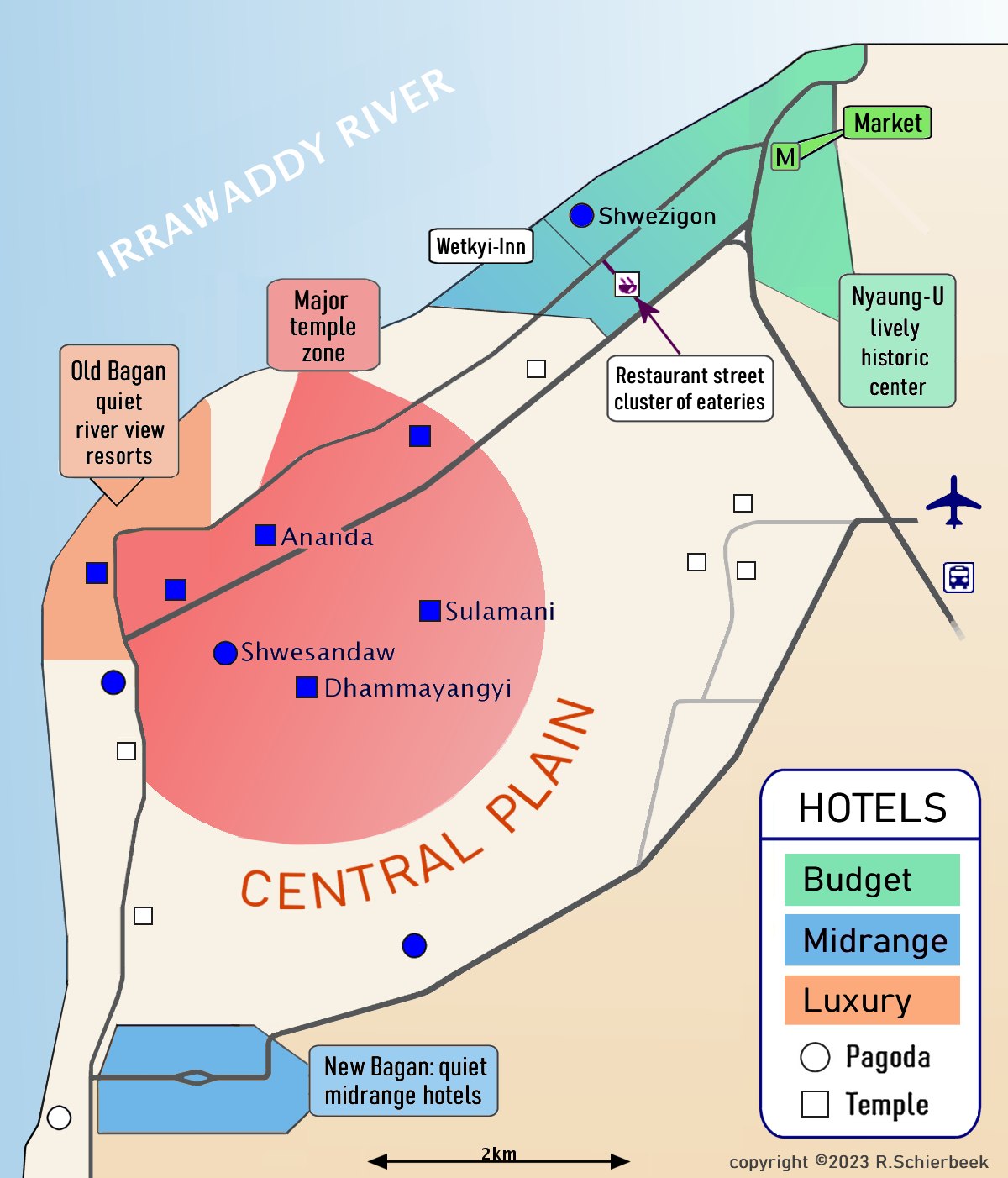



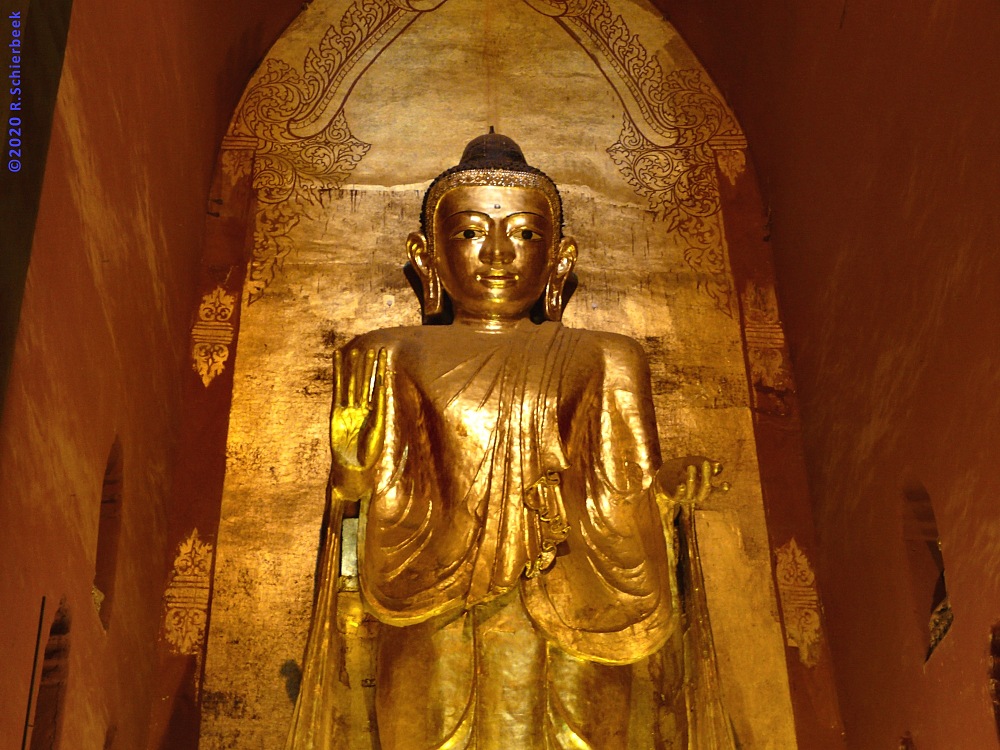
 The third type of building in Bagan is the "Kyaung"; a small stone building, usually in the shape that resembles a cube, or sometimes a rectangular block. "Kyaung" is Burmese for monastery. Many of these small stone buildings were used as sleeping quarters, some are larger, for example the Shin Bo Me Ok Kyaung, just west of Nyaung-U.
The third type of building in Bagan is the "Kyaung"; a small stone building, usually in the shape that resembles a cube, or sometimes a rectangular block. "Kyaung" is Burmese for monastery. Many of these small stone buildings were used as sleeping quarters, some are larger, for example the Shin Bo Me Ok Kyaung, just west of Nyaung-U.



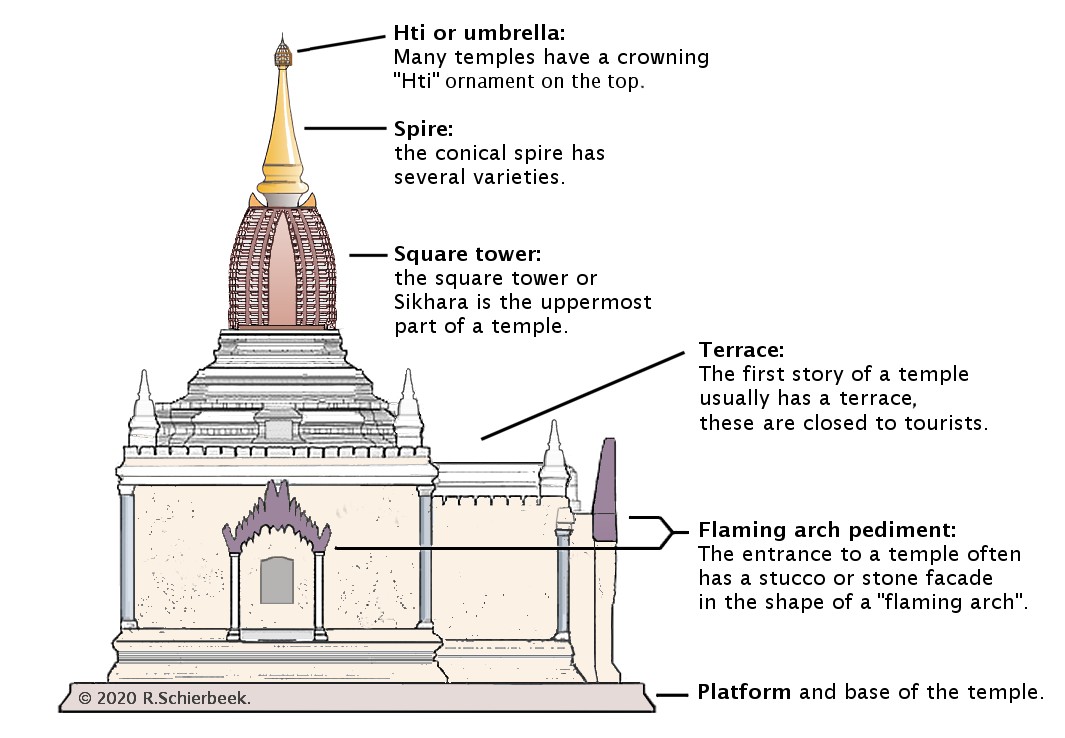

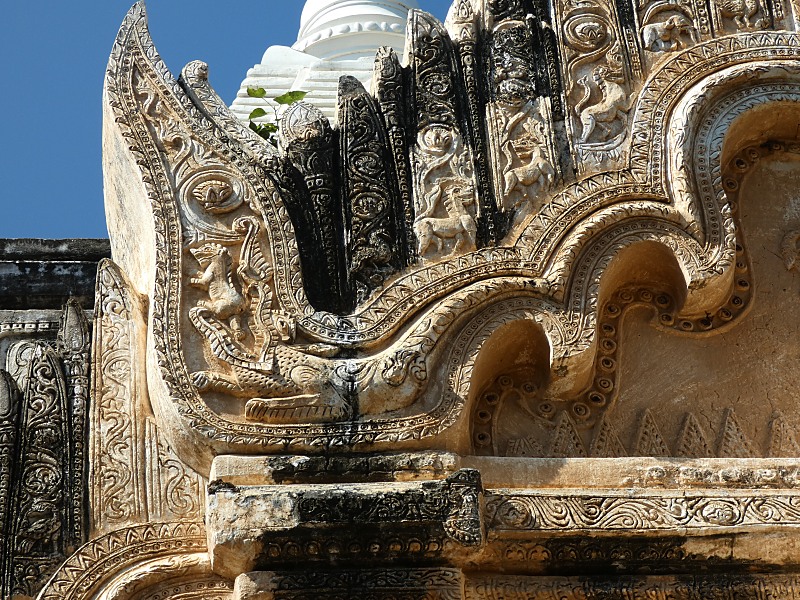
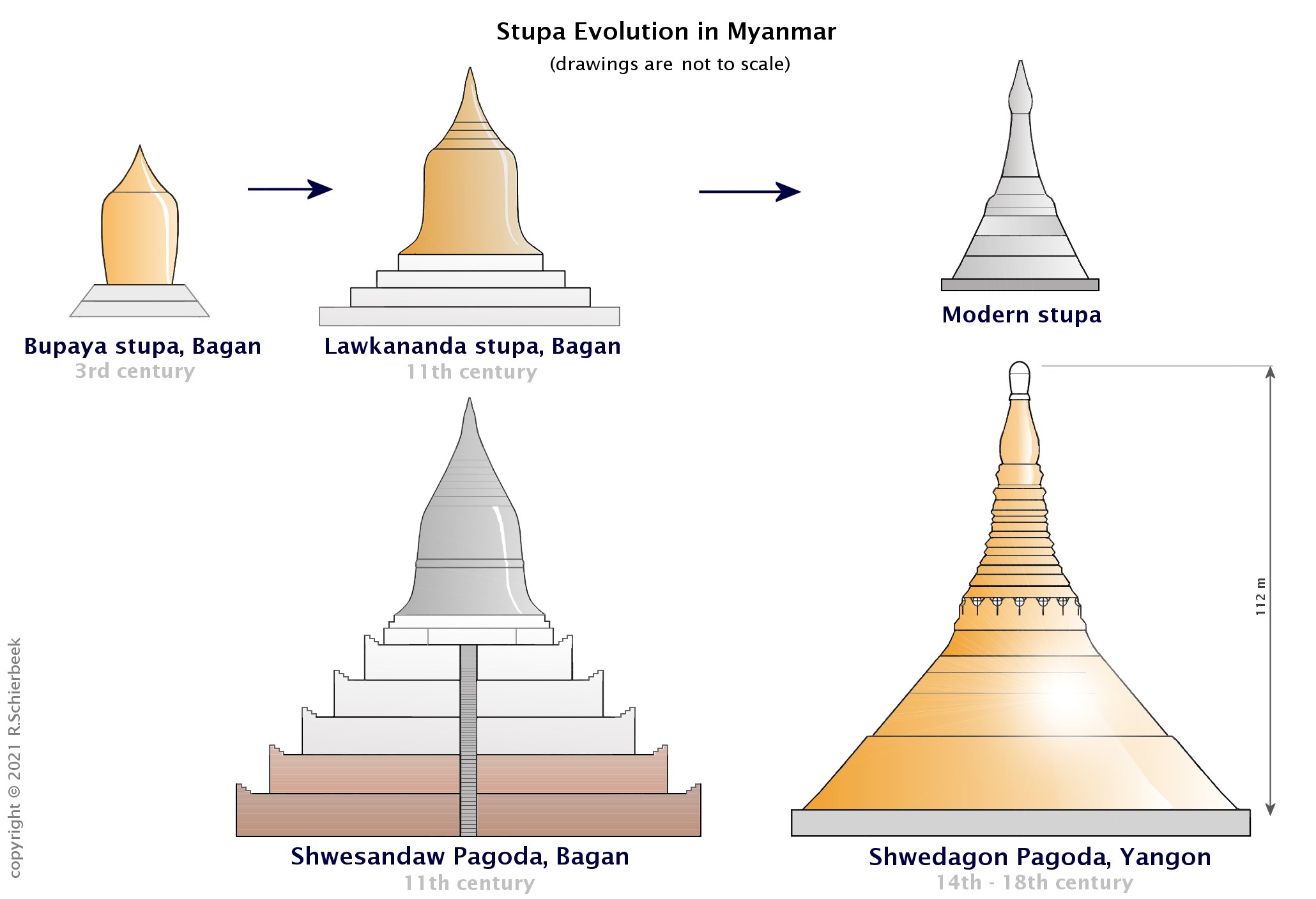
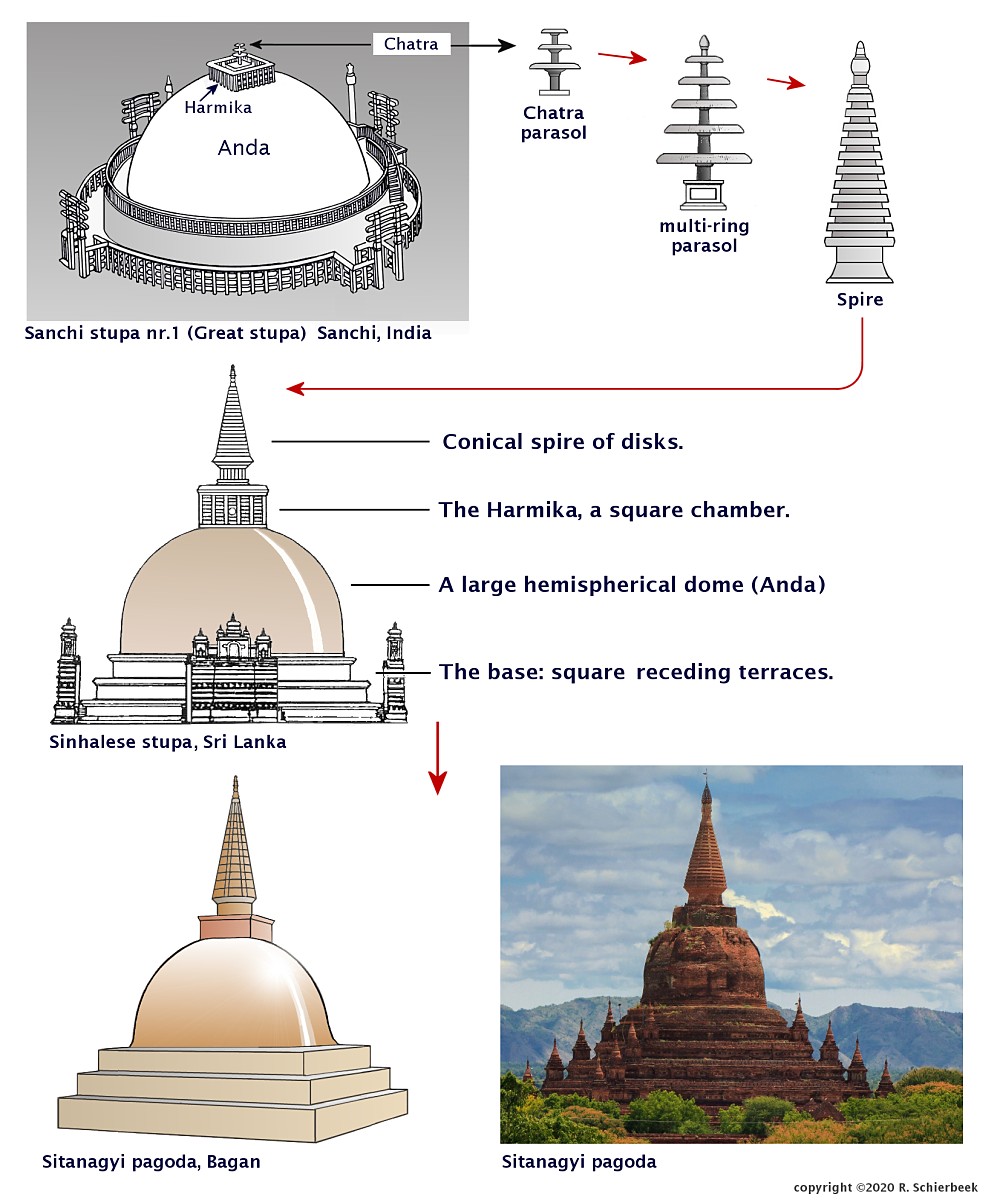
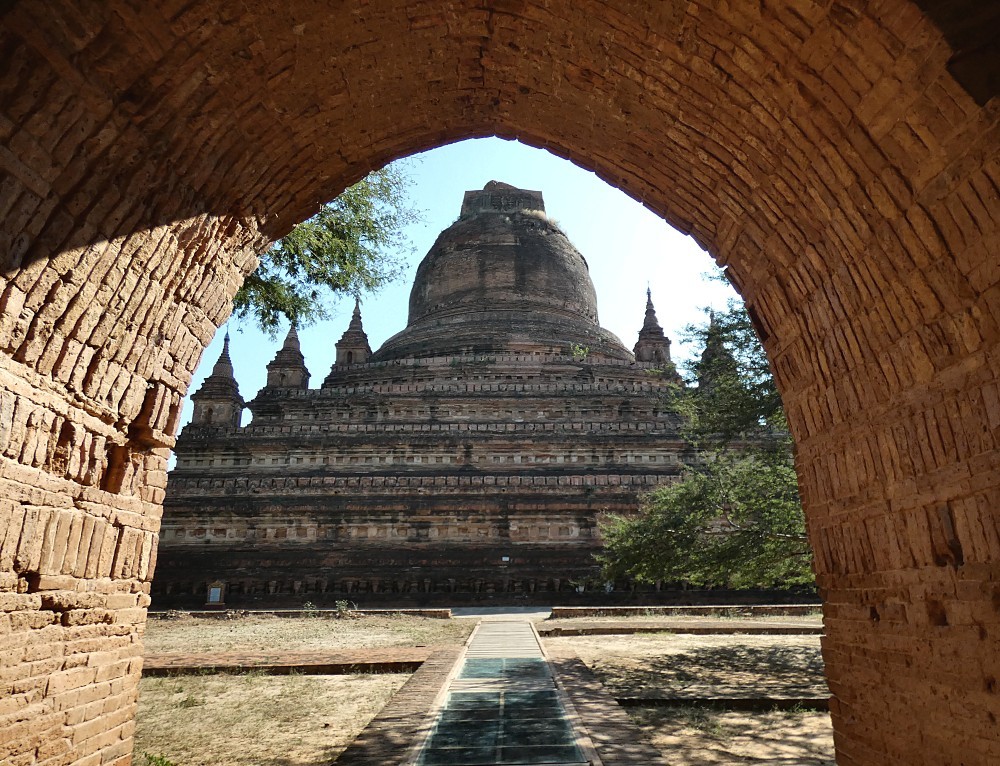
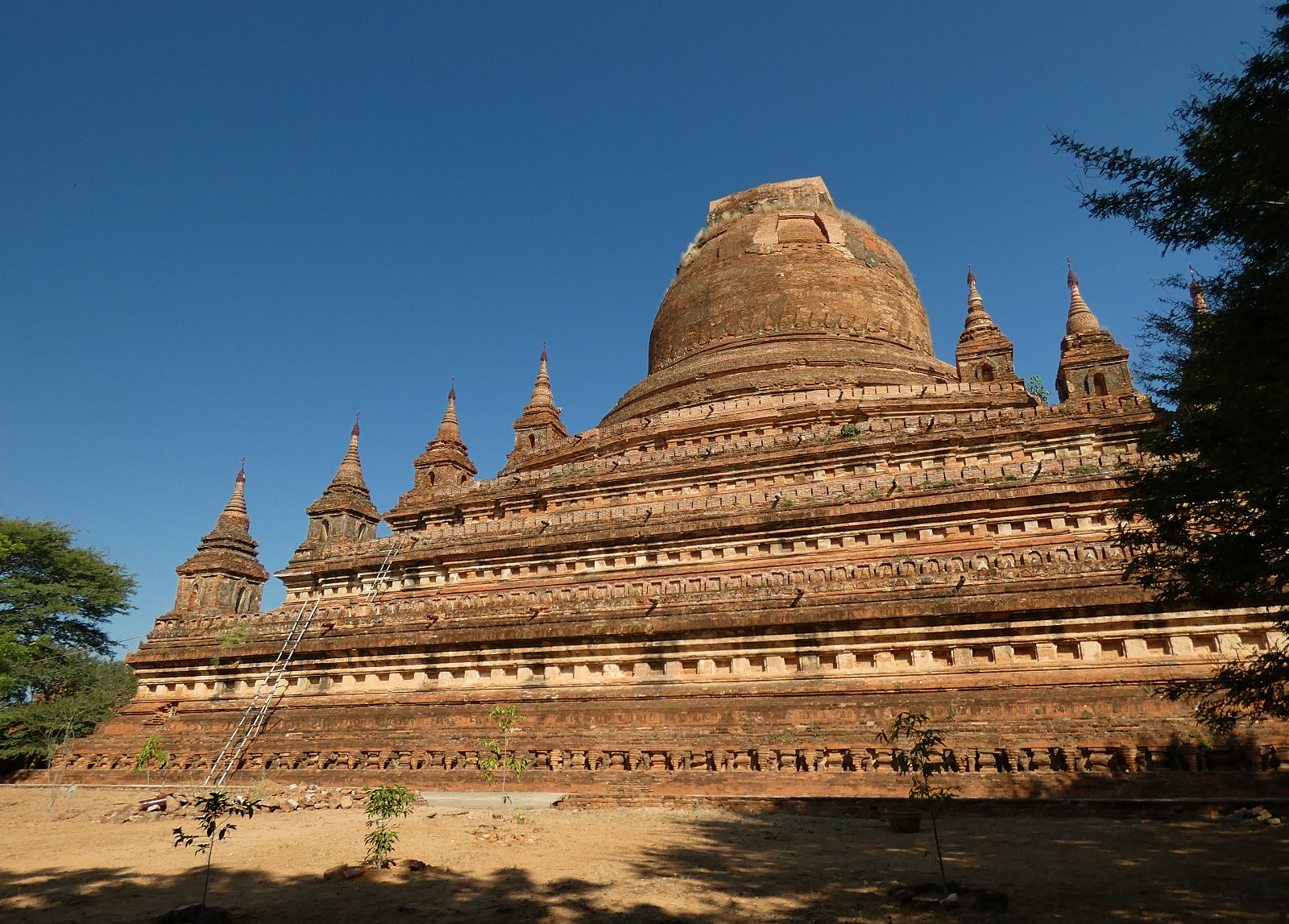
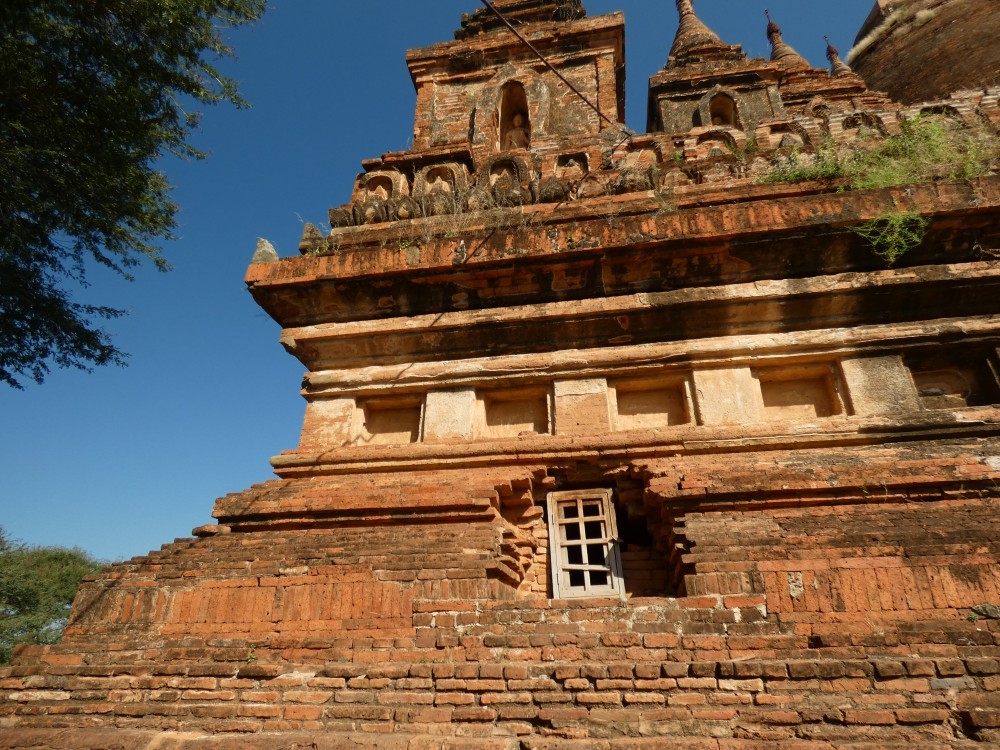
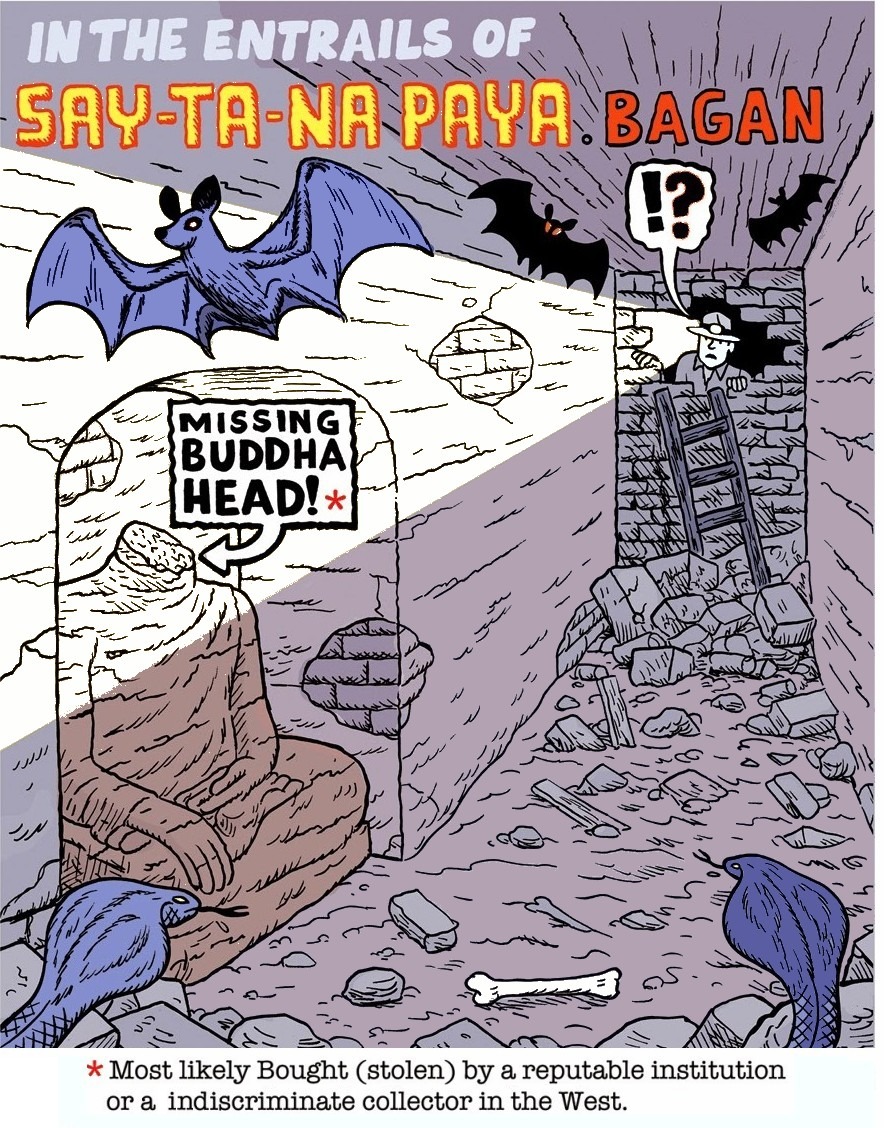 The grandma of the caretaker's family was there, and she also suggested me to have a look inside. This time I was curious to see what was beyond the small door, and I accepted her suggestion.
The grandma of the caretaker's family was there, and she also suggested me to have a look inside. This time I was curious to see what was beyond the small door, and I accepted her suggestion.
 The Inventory made by Pichard has a total number of 2730 structures. A total of 1471 buildings were categorized as half-ruined, completely ruined or rubble mounds. The number of rebuilt temples was 448. Only 811 temples, stupas, pagoda's and kyaungs were more or less intact; which is 30% of all structures.
The Inventory made by Pichard has a total number of 2730 structures. A total of 1471 buildings were categorized as half-ruined, completely ruined or rubble mounds. The number of rebuilt temples was 448. Only 811 temples, stupas, pagoda's and kyaungs were more or less intact; which is 30% of all structures.
